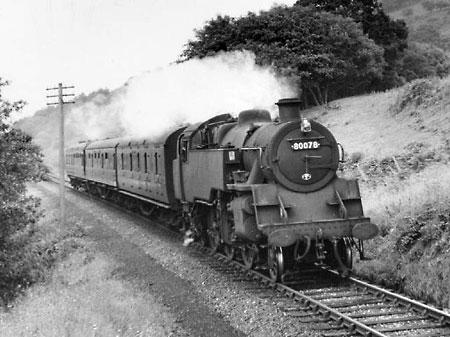BR Standard 2-6-4T Class 4 Mixed Traffic
A Brief History
When British Railways were formed in 1948 they inherited a large number of different classes of locomotives, some of which dated back to the 19th century. A number of locomotives to designs by the constituent companies continued to be manufactured during this early phase of British Railways but plans were soon put into operation to develop a number of Standard designs based on the best practices of the four constituent companies.
The result of this standardisation was the construction of 999 locomotives to twelve different designs under the supervision of R.A.Riddles, the British Railways Chief Mechanical Engineer, known collectively as 'Standards' during the period 1951 to 1960.
One of the most successful of these Riddles designs were the Class 4, 2-6-4 Tank locomotives of which 155 were built at Brighton and Derby from 1951 to 1957.
 |
80078 near Cemmes on the Cambrian line |
The ancestry of these engines is easily traced back to the Class Four 2-6-4T designs of both Stanier and Fairburn on the London Midland & Scottish Railway. The Standard Fours share much of their basic design with these older cousins, including their wheel arrangements, but they were much modified in detail. For example, to fit the new L1 universal loading gauge the cylinders were reduced in diameter, necessitating an increase in boiler pressure, etc. Aesthetically at least, the changes combined to produce a much more handsome locomotive than the relatively workaday appearance of the LMS engines. They seem to have been better liked by their crews too, probably for their more comfortable cabs, freer running and more economical operation.
The arrival of diesel multiple units and the electrification of many suburban routes resulted in these versatile and useful machines being sent for scrap with many years useful life left in them.
Fortunately 14 of these locomotives ended up at Woodham's scrap yard in Barry and have since been purchased for restoration. They are an almost ideal engine for preserved railways in that they are a relatively modern design, economical, and quite capable of handling the sort of loads found on preserved railways.Technical Details
| Wheel Arrangement: | 2-6-4 |
| Cylinders (2): | 18in. x 28in. |
| Boiler Pressure: | 225 lb/sq.in. |
| Tractive Effort: | 25,100 lb. |
| Power Classification: | 4MT |
| Driving Wheel Diameter: | 5ft. 8in. |
| Pony Wheel Diameter: | 3ft. |
| Trailing Wheel Diameter: | 3ft. |
| Length: | 36ft. 10in. |
| Weight: | 88 tons 10 cwt. |
| Water Capacity: | 2,000 gals. |
| Coal Capacity: | 3 tons 10 cwt. |
